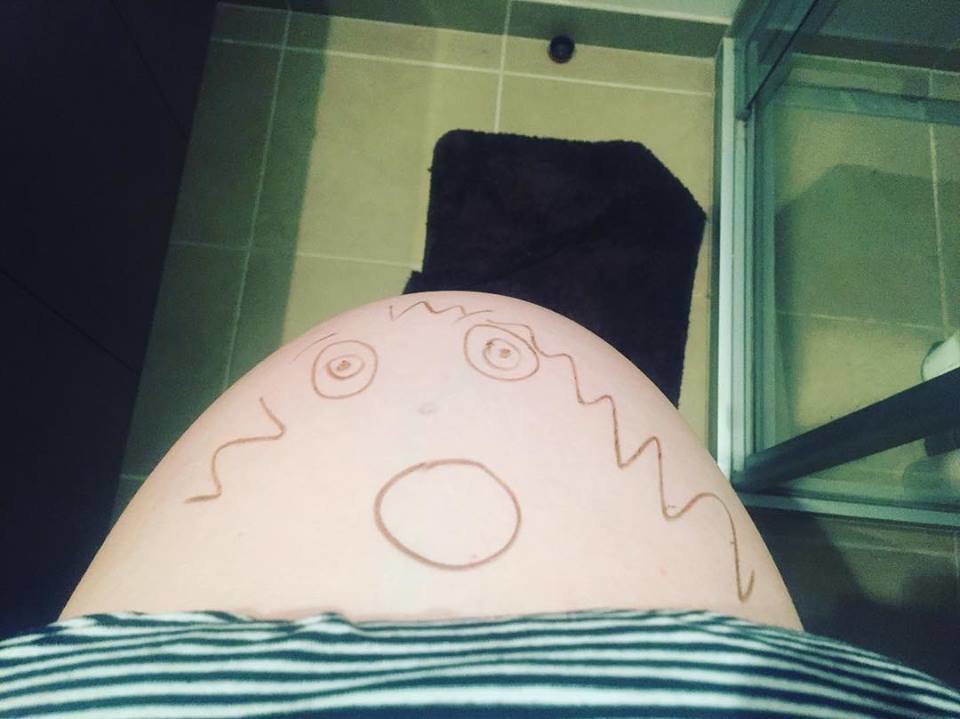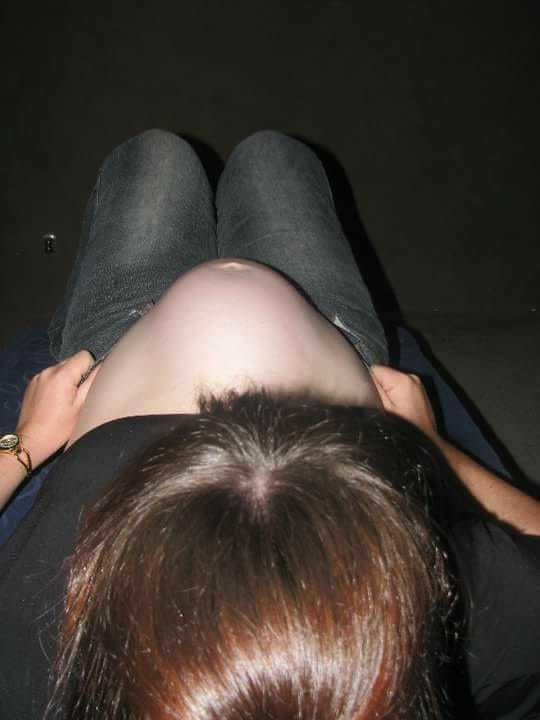
A woman's midsection drastically changes shape as she carries a growing life, but this popping baby bump can take on some unusual shapes. Sometimes it's because the little one is kicking or poking an elbow out; other times it's because the uterus is hardening with a contraction. Laura Mazza is currently pregnant with her third baby, and she once thought that her bump's cone shape was due to how she carried. However, she knows now that it's from a muscle condition that two-thirds of expectant moms have.
Mazza noticed that her bump looked like "a real big cone" when she was planking.

"This will seem so obvious to most people but for me I had no idea. Muscle separation in pregnancy is normal but when your stomach looks like a real big cone, it's actually signs of a big separation … " Mazza wrote on her Facebook page, Mum on the Run. "I honestly used to think that it was my baby's back lol."
Abdominal separation is common among pregnant women because as the uterus grows, it stretches those muscles. Although it's reported that a majority of moms-to-be have this space between their right and left abdominal muscles, known as diastasis recti, many don't realize it. According to Mayo Clinic, this "bulge" in the front of your bump can become more noticeable when the abdominal muscles are tense — which is exactly how Mazza spotted it.
"Extra skin and soft tissue in the front of the abdominal wall may be the only signs of this condition in early pregnancy. In the later part of pregnancy, the top of the pregnant uterus can be seen bulging out of the abdominal wall," Medline Plus explains. "An outline of parts of the unborn baby may be seen in some severe cases.
Diastasis recti is what causes the "mom pouch" that so many postpartum mamas can't stand.

According to Diana Ramos, MD, OB/GYN, cochair of the National Preconception Health and Health Care Initiative, the same muscles that are responsible for giving people that coveted six-pack are also what leave women with the "tummy pouch" when they separate.
"A new mom can still looked pregnant even months after delivery," she tells CafeMom. "The cause is the growing baby pushing on the abdominal muscles apart, and increased risk factors are weight gain during pregnancy, large baby, twins, cesarean section, [and] lifting more than 20 pounds a week (i.e., a toddler)."
On Facebook, Mazza shared her bump before and after activating those muscles, to show other moms what the condition can look like in real life. "If you have kids and you do a plank and notice it droop or lean back, and you still have the cone, it means your muscles are still separated," she wrote. "This has been a public service announcement brought to you by me, who clearly spends too much time looking for her feet (and her vagina)."
Luckily, there are things you can do to help prevent it.

Diastasis recti can also occur in men as well as women who are not pregnant, and symptoms can include lower back pain, bloating, constipation, and problems with posture. It's most noticeable during pregnancy as a "bulge" near the belly button when a mom uses her ab muscles; post-pregnancy, it's typically noticed when a mom forms that postpartum pooch. After birth, it can be diagnosed by a doctor feeling if there's a gap in between the abdominal muscles that's bigger than one or two finger lengths.
According to Ramos, there's one thing that moms-to-be can do before having a baby in order to decrease their chances of having this happen. "Before you become pregnant, work on developing a strong core," she says.
After a woman gets pregnant and her bump begins to grow, she should also consider doing the "log roll" whenever she's getting up from laying on the couch or bed. Ben Butts, PT, director of rehabilitation services and performance therapy at Providence Saint John's Health Center, explained to Parents how the maneuver works: Instead of sitting upright, mamas should roll to one side and then use their arms to help prop them in order to ease straining those abdominal muscles.
FEATURED VIDEO:
But there's no need to worry if you do get it -- specific workouts can help.

Once a mom gets cleared to work out after having a baby, she shouldn't necessarily plan on jumping into her favorite workouts to blast those abs back together. Despite what you assume, Ramos warns against focusing on a variety of different ab exercises aimed at making midsections tighter — and some need to be skipped at all costs to prevent further damage. "Make sure you AVOID sit-ups, bicycle or crossover crunches; this can make things worse," she says.
Instead, the first thing to building back that core after baby should be focusing on isometric contractions of the transverse abdominis muscles, according to Ramos. "They are often referred to as the abdominal muscular 'girdle,' and developing them will aid in getting rid of the 'tummy pouch,'" she says. "The results will be gradual, up to a few months, but remember, it took nine months to develop your 'tummy pouch.'"
Many on Facebook had never seen this before and think the "doming" is pretty damn cool.

Others had this, but had no idea that it was from muscle separation -- and their minds are blown.

"I used to call my cone shaped bump the shark fin lol," one mom joked.
"Oh my god that's what I had while I was pregnant?! I feel like my OB should have said something…" one mom commented.
"Huh you really do learn something new every day! I didn't know this. It would freak me out when it happened," another added.
And some still have "coning" postpartum.

Although the separation can naturally heal in the weeks and months after delivery, some moms do need surgery to correct the problem — and not always just for cosmetic reasons. "People can start feeling some back pain because the core is weakened," Dr. Geeta Sharma, an ob-gyn at Weill Cornell Medical Center-New York Presbyterian Hospital, told NPR. "If there's a defect in a layer of tissue called the linea alba, then the bowel can poke through. That's going to be more dangerous."
But the moral of the story for many moms: Have a sense of humor and skip the planks!

"After 5 kids … all C-sections, I have come to accept that my stomach and anything resembling what muscle I have or had, are shot. I still have this weird cone shape when I suck it in lol," one user commented. "Now I know why. Ugh. Oh well. Yay for mom pooches "
"Yeah, who the hell planks anyway! Xx" another added.




